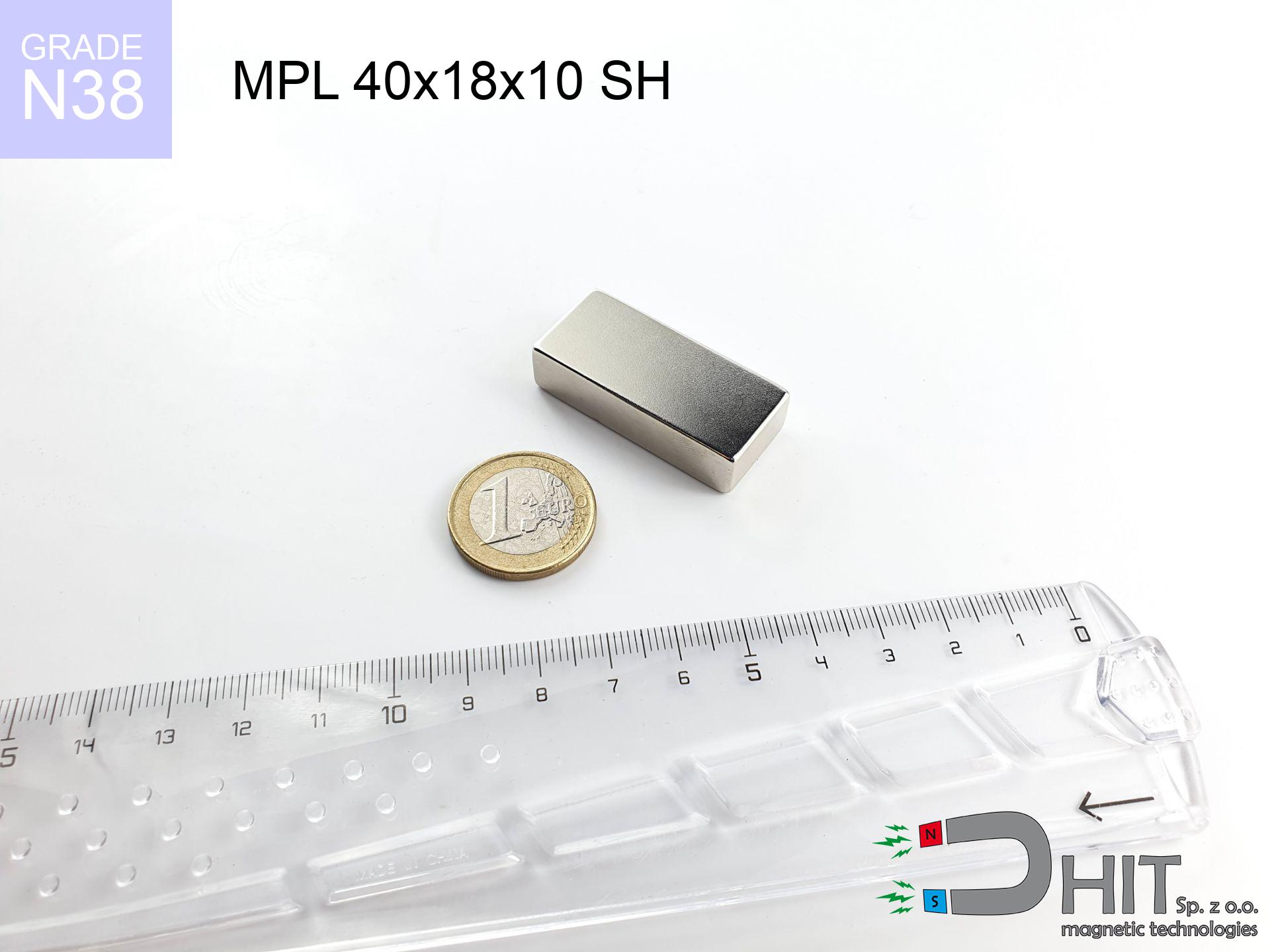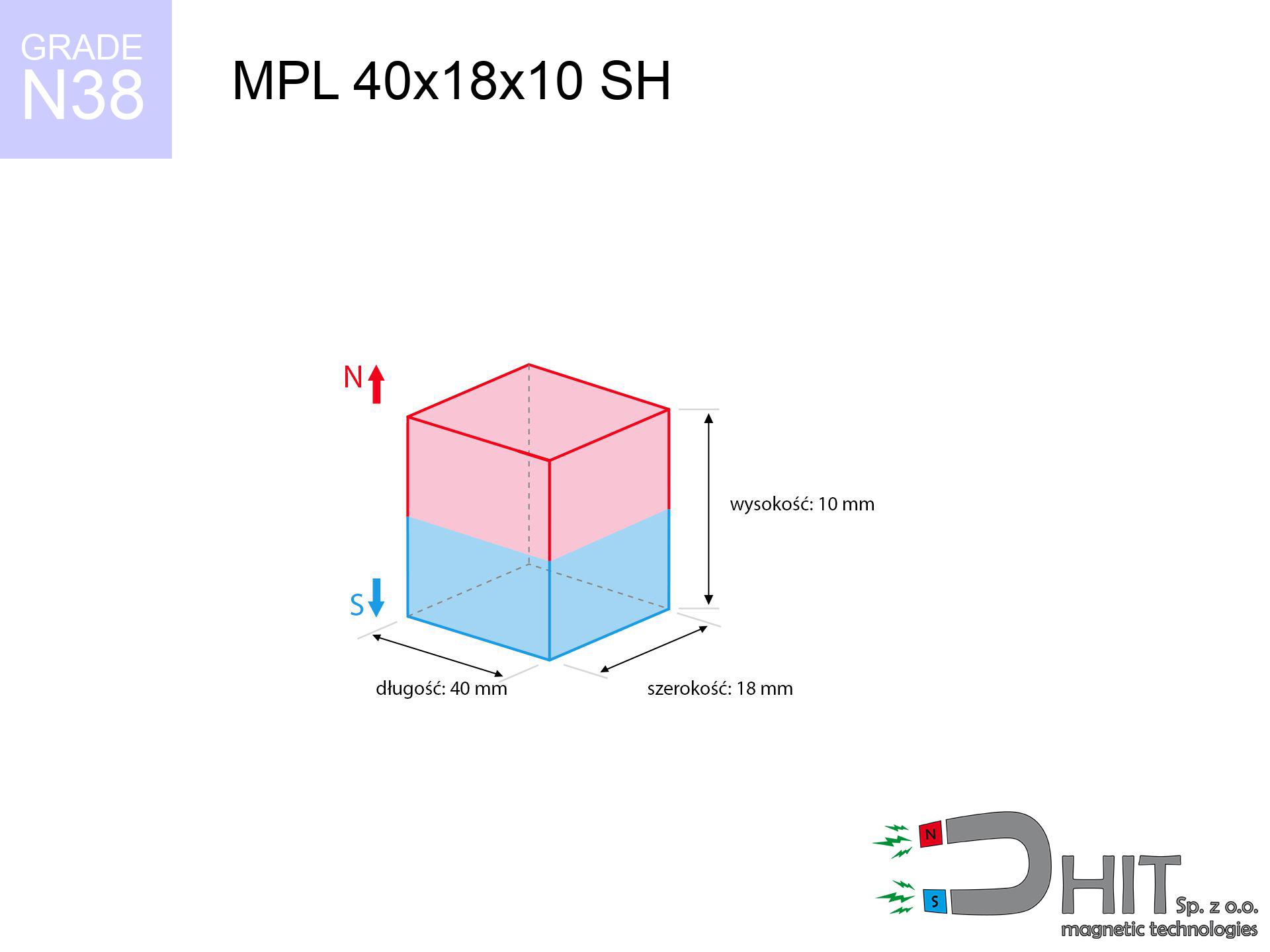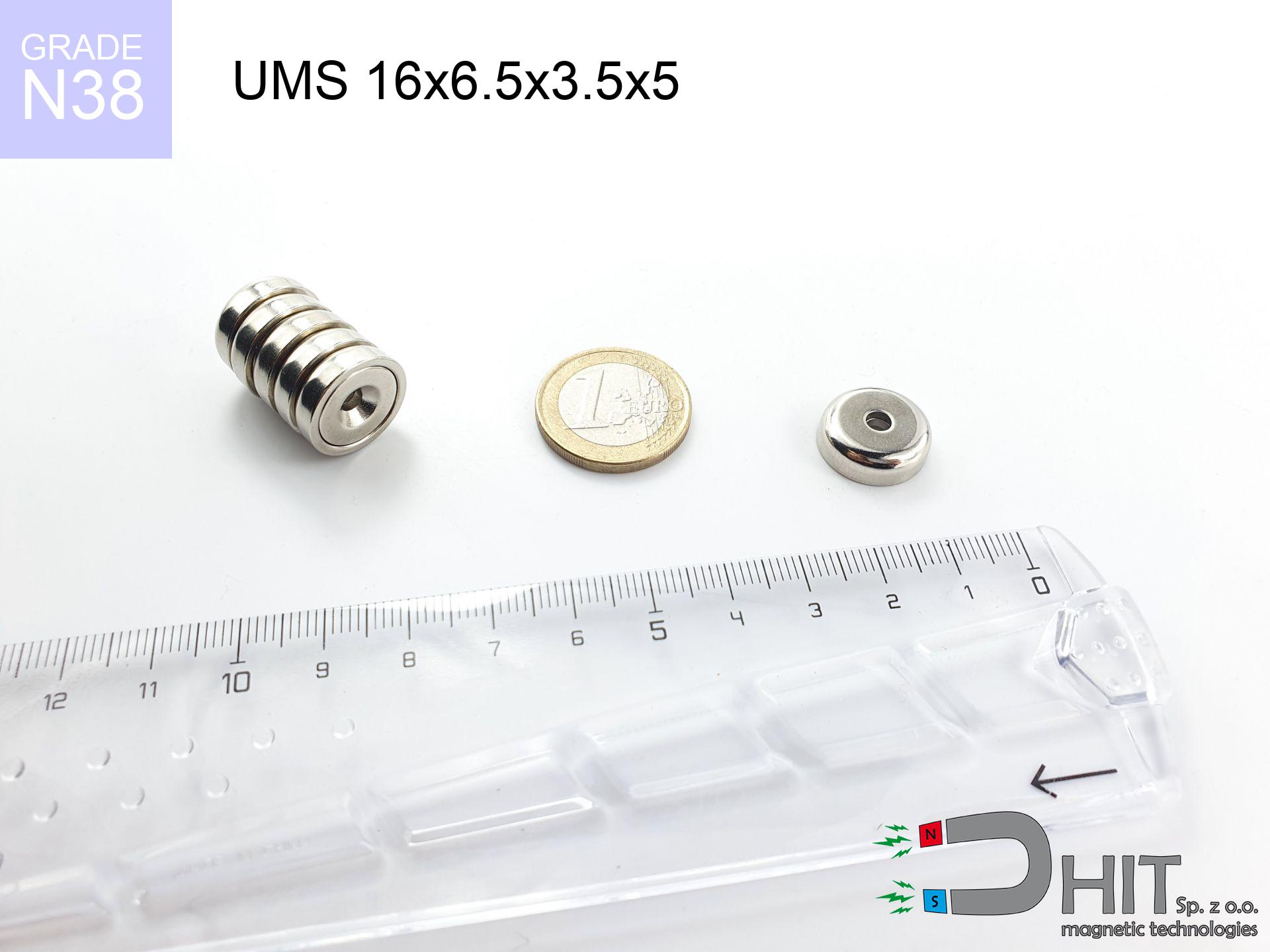MPL 40x18x10 SH / N38 - lamellar magnet
lamellar magnet
Catalog no 020157
GTIN/EAN: 5906301811633
length
40 mm [±0,1 mm]
Width
18 mm [±0,1 mm]
Height
10 mm [±0,1 mm]
Weight
54 g
Magnetization Direction
↑ axial
Load capacity
23.81 kg / 233.58 N
Magnetic Induction
366.66 mT / 3667 Gs
Coating
[NiCuNi] Nickel
36.29 ZŁ with VAT / pcs + price for transport
29.50 ZŁ net + 23% VAT / pcs
bulk discounts:
Need more?
Give us a call
+48 888 99 98 98
otherwise send us a note via
our online form
the contact section.
Force along with appearance of magnetic components can be analyzed with our
online calculation tool.
Same-day shipping for orders placed before 14:00.
Product card - MPL 40x18x10 SH / N38 - lamellar magnet
Specification / characteristics - MPL 40x18x10 SH / N38 - lamellar magnet
| properties | values |
|---|---|
| Cat. no. | 020157 |
| GTIN/EAN | 5906301811633 |
| Production/Distribution | Dhit sp. z o.o. |
| Country of origin | Poland / China / Germany |
| Customs code | 85059029 |
| length | 40 mm [±0,1 mm] |
| Width | 18 mm [±0,1 mm] |
| Height | 10 mm [±0,1 mm] |
| Weight | 54 g |
| Magnetization Direction | ↑ axial |
| Load capacity ~ ? | 23.81 kg / 233.58 N |
| Magnetic Induction ~ ? | 366.66 mT / 3667 Gs |
| Coating | [NiCuNi] Nickel |
| Manufacturing Tolerance | ±0.1 mm |
Magnetic properties of material N38
| properties | values | units |
|---|---|---|
| remenance Br [min. - max.] ? | 12.2-12.6 | kGs |
| remenance Br [min. - max.] ? | 1220-1260 | mT |
| coercivity bHc ? | 10.8-11.5 | kOe |
| coercivity bHc ? | 860-915 | kA/m |
| actual internal force iHc | ≥ 12 | kOe |
| actual internal force iHc | ≥ 955 | kA/m |
| energy density [min. - max.] ? | 36-38 | BH max MGOe |
| energy density [min. - max.] ? | 287-303 | BH max KJ/m |
| max. temperature ? | ≤ 80 | °C |
Physical properties of sintered neodymium magnets Nd2Fe14B at 20°C
| properties | values | units |
|---|---|---|
| Vickers hardness | ≥550 | Hv |
| Density | ≥7.4 | g/cm3 |
| Curie Temperature TC | 312 - 380 | °C |
| Curie Temperature TF | 593 - 716 | °F |
| Specific resistance | 150 | μΩ⋅cm |
| Bending strength | 250 | MPa |
| Compressive strength | 1000~1100 | MPa |
| Thermal expansion parallel (∥) to orientation (M) | (3-4) x 10-6 | °C-1 |
| Thermal expansion perpendicular (⊥) to orientation (M) | -(1-3) x 10-6 | °C-1 |
| Young's modulus | 1.7 x 104 | kg/mm² |
Engineering analysis of the product - report
Presented information are the direct effect of a mathematical calculation. Results are based on algorithms for the class Nd2Fe14B. Operational conditions may deviate from the simulation results. Use these calculations as a preliminary roadmap when designing systems.
Table 1: Static force (force vs gap) - power drop
MPL 40x18x10 SH / N38
| Distance (mm) | Induction (Gauss) / mT | Pull Force (kg) | Risk Status |
|---|---|---|---|
| 0 mm |
3666 Gs
366.6 mT
|
23.81 kg / 23810.0 g
233.6 N
|
crushing |
| 1 mm |
3399 Gs
339.9 mT
|
20.48 kg / 20476.1 g
200.9 N
|
crushing |
| 2 mm |
3120 Gs
312.0 mT
|
17.25 kg / 17245.9 g
169.2 N
|
crushing |
| 3 mm |
2841 Gs
284.1 mT
|
14.30 kg / 14304.1 g
140.3 N
|
crushing |
| 5 mm |
2321 Gs
232.1 mT
|
9.55 kg / 9547.8 g
93.7 N
|
warning |
| 10 mm |
1370 Gs
137.0 mT
|
3.32 kg / 3324.4 g
32.6 N
|
warning |
| 15 mm |
833 Gs
83.3 mT
|
1.23 kg / 1229.0 g
12.1 N
|
weak grip |
| 20 mm |
530 Gs
53.0 mT
|
0.50 kg / 498.1 g
4.9 N
|
weak grip |
| 30 mm |
244 Gs
24.4 mT
|
0.11 kg / 105.3 g
1.0 N
|
weak grip |
| 50 mm |
75 Gs
7.5 mT
|
0.01 kg / 9.9 g
0.1 N
|
weak grip |
Table 2: Vertical capacity (wall)
MPL 40x18x10 SH / N38
| Distance (mm) | Friction coefficient | Pull Force (kg) |
|---|---|---|
| 0 mm | Stal (~0.2) |
4.76 kg / 4762.0 g
46.7 N
|
| 1 mm | Stal (~0.2) |
4.10 kg / 4096.0 g
40.2 N
|
| 2 mm | Stal (~0.2) |
3.45 kg / 3450.0 g
33.8 N
|
| 3 mm | Stal (~0.2) |
2.86 kg / 2860.0 g
28.1 N
|
| 5 mm | Stal (~0.2) |
1.91 kg / 1910.0 g
18.7 N
|
| 10 mm | Stal (~0.2) |
0.66 kg / 664.0 g
6.5 N
|
| 15 mm | Stal (~0.2) |
0.25 kg / 246.0 g
2.4 N
|
| 20 mm | Stal (~0.2) |
0.10 kg / 100.0 g
1.0 N
|
| 30 mm | Stal (~0.2) |
0.02 kg / 22.0 g
0.2 N
|
| 50 mm | Stal (~0.2) |
0.00 kg / 2.0 g
0.0 N
|
Table 3: Wall mounting (sliding) - behavior on slippery surfaces
MPL 40x18x10 SH / N38
| Surface type | Friction coefficient / % Mocy | Max load (kg) |
|---|---|---|
| Raw steel |
µ = 0.3
30% Nominalnej Siły
|
7.14 kg / 7143.0 g
70.1 N
|
| Painted steel (standard) |
µ = 0.2
20% Nominalnej Siły
|
4.76 kg / 4762.0 g
46.7 N
|
| Oily/slippery steel |
µ = 0.1
10% Nominalnej Siły
|
2.38 kg / 2381.0 g
23.4 N
|
| Magnet with anti-slip rubber |
µ = 0.5
50% Nominalnej Siły
|
11.91 kg / 11905.0 g
116.8 N
|
Table 4: Material efficiency (saturation) - power losses
MPL 40x18x10 SH / N38
| Steel thickness (mm) | % power | Real pull force (kg) |
|---|---|---|
| 0.5 mm |
|
1.19 kg / 1190.5 g
11.7 N
|
| 1 mm |
|
2.98 kg / 2976.3 g
29.2 N
|
| 2 mm |
|
5.95 kg / 5952.5 g
58.4 N
|
| 5 mm |
|
14.88 kg / 14881.3 g
146.0 N
|
| 10 mm |
|
23.81 kg / 23810.0 g
233.6 N
|
Table 5: Thermal stability (stability) - thermal limit
MPL 40x18x10 SH / N38
| Ambient temp. (°C) | Power loss | Remaining pull | Status |
|---|---|---|---|
| 20 °C | 0.0% |
23.81 kg / 23810.0 g
233.6 N
|
OK |
| 40 °C | -2.2% |
23.29 kg / 23286.2 g
228.4 N
|
OK |
| 60 °C | -4.4% |
22.76 kg / 22762.4 g
223.3 N
|
|
| 80 °C | -6.6% |
22.24 kg / 22238.5 g
218.2 N
|
|
| 100 °C | -28.8% |
16.95 kg / 16952.7 g
166.3 N
|
Table 6: Magnet-Magnet interaction (attraction) - field collision
MPL 40x18x10 SH / N38
| Gap (mm) | Attraction (kg) (N-S) | Repulsion (kg) (N-N) |
|---|---|---|
| 0 mm |
59.64 kg / 59645 g
585.1 N
5 034 Gs
|
N/A |
| 1 mm |
55.50 kg / 55499 g
544.4 N
7 072 Gs
|
49.95 kg / 49949 g
490.0 N
~0 Gs
|
| 2 mm |
51.29 kg / 51293 g
503.2 N
6 799 Gs
|
46.16 kg / 46164 g
452.9 N
~0 Gs
|
| 3 mm |
47.18 kg / 47176 g
462.8 N
6 520 Gs
|
42.46 kg / 42459 g
416.5 N
~0 Gs
|
| 5 mm |
39.41 kg / 39410 g
386.6 N
5 959 Gs
|
35.47 kg / 35469 g
348.0 N
~0 Gs
|
| 10 mm |
23.92 kg / 23918 g
234.6 N
4 643 Gs
|
21.53 kg / 21526 g
211.2 N
~0 Gs
|
| 20 mm |
8.33 kg / 8328 g
81.7 N
2 739 Gs
|
7.49 kg / 7495 g
73.5 N
~0 Gs
|
| 50 mm |
0.55 kg / 552 g
5.4 N
705 Gs
|
0.50 kg / 497 g
4.9 N
~0 Gs
|
Table 7: Hazards (electronics) - precautionary measures
MPL 40x18x10 SH / N38
| Object / Device | Limit (Gauss) / mT | Safe distance |
|---|---|---|
| Pacemaker | 5 Gs (0.5 mT) | 14.0 cm |
| Hearing aid | 10 Gs (1.0 mT) | 11.0 cm |
| Mechanical watch | 20 Gs (2.0 mT) | 8.5 cm |
| Phone / Smartphone | 40 Gs (4.0 mT) | 6.5 cm |
| Car key | 50 Gs (5.0 mT) | 6.0 cm |
| Payment card | 400 Gs (40.0 mT) | 2.5 cm |
| HDD hard drive | 600 Gs (60.0 mT) | 2.0 cm |
Table 8: Impact energy (kinetic energy) - warning
MPL 40x18x10 SH / N38
| Start from (mm) | Speed (km/h) | Energy (J) | Predicted outcome |
|---|---|---|---|
| 10 mm |
22.95 km/h
(6.38 m/s)
|
1.10 J | |
| 30 mm |
36.78 km/h
(10.22 m/s)
|
2.82 J | |
| 50 mm |
47.37 km/h
(13.16 m/s)
|
4.67 J | |
| 100 mm |
66.97 km/h
(18.60 m/s)
|
9.34 J |
Table 9: Surface protection spec
MPL 40x18x10 SH / N38
| Technical parameter | Value / Description |
|---|---|
| Coating type | [NiCuNi] Nickel |
| Layer structure | Nickel - Copper - Nickel |
| Layer thickness | 10-20 µm |
| Salt spray test (SST) ? | 24 h |
| Recommended environment | Indoors only (dry) |
Table 10: Electrical data (Flux)
MPL 40x18x10 SH / N38
| Parameter | Value | SI Unit / Description |
|---|---|---|
| Magnetic Flux | 26 060 Mx | 260.6 µWb |
| Pc Coefficient | 0.43 | Low (Flat) |
Table 11: Hydrostatics and buoyancy
MPL 40x18x10 SH / N38
| Environment | Effective steel pull | Effect |
|---|---|---|
| Air (land) | 23.81 kg | Standard |
| Water (riverbed) |
27.26 kg
(+3.45 kg Buoyancy gain)
|
+14.5% |
1. Sliding resistance
*Warning: On a vertical surface, the magnet holds only approx. 20-30% of its nominal pull.
2. Plate thickness effect
*Thin steel (e.g. computer case) severely reduces the holding force.
3. Temperature resistance
*For N38 material, the safety limit is 80°C.
4. Demagnetization curve and operating point (B-H)
chart generated for the permeance coefficient Pc (Permeance Coefficient) = 0.43
This simulation demonstrates the magnetic stability of the selected magnet under specific geometric conditions. The solid red line represents the demagnetization curve (material potential), while the dashed blue line is the load line based on the magnet's geometry. The Pc (Permeance Coefficient), also known as the load line slope, is a dimensionless value that describes the relationship between the magnet's shape and its magnetic stability. The intersection of these two lines (the black dot) is the operating point — it determines the actual magnetic flux density generated by the magnet in this specific configuration. A higher Pc value means the magnet is more 'slender' (tall relative to its area), resulting in a higher operating point and better resistance to irreversible demagnetization caused by external fields or temperature. A value of 0.42 is relatively low (typical for flat magnets), meaning the operating point is closer to the 'knee' of the curve — caution is advised when operating at temperatures near the maximum limit to avoid strength loss.
Material specification
| iron (Fe) | 64% – 68% |
| neodymium (Nd) | 29% – 32% |
| boron (B) | 1.1% – 1.2% |
| dysprosium (Dy) | 0.5% – 2.0% |
| coating (Ni-Cu-Ni) | < 0.05% |
Sustainability
| recyclability (EoL) | 100% |
| recycled raw materials | ~10% (pre-cons) |
| carbon footprint | low / zredukowany |
| waste code (EWC) | 16 02 16 |
Check out also deals
Advantages as well as disadvantages of neodymium magnets.
Advantages
- They have constant strength, and over around 10 years their attraction force decreases symbolically – ~1% (according to theory),
- They are extremely resistant to demagnetization induced by external field influence,
- The use of an aesthetic finish of noble metals (nickel, gold, silver) causes the element to have aesthetics,
- The surface of neodymium magnets generates a strong magnetic field – this is one of their assets,
- Through (adequate) combination of ingredients, they can achieve high thermal resistance, enabling functioning at temperatures reaching 230°C and above...
- Possibility of exact forming and adapting to atypical applications,
- Key role in future technologies – they find application in data components, brushless drives, precision medical tools, as well as other advanced devices.
- Relatively small size with high pulling force – neodymium magnets offer strong magnetic field in tiny dimensions, which allows their use in miniature devices
Cons
- Susceptibility to cracking is one of their disadvantages. Upon intense impact they can fracture. We advise keeping them in a special holder, which not only protects them against impacts but also increases their durability
- We warn that neodymium magnets can lose their power at high temperatures. To prevent this, we advise our specialized [AH] magnets, which work effectively even at 230°C.
- Due to the susceptibility of magnets to corrosion in a humid environment, we suggest using waterproof magnets made of rubber, plastic or other material immune to moisture, in case of application outdoors
- Limited ability of creating nuts in the magnet and complex forms - preferred is casing - magnet mounting.
- Possible danger to health – tiny shards of magnets pose a threat, if swallowed, which becomes key in the context of child safety. It is also worth noting that tiny parts of these devices can complicate diagnosis medical after entering the body.
- Higher cost of purchase is one of the disadvantages compared to ceramic magnets, especially in budget applications
Pull force analysis
Maximum holding power of the magnet – what contributes to it?
- with the application of a sheet made of special test steel, guaranteeing maximum field concentration
- whose transverse dimension equals approx. 10 mm
- with an ground contact surface
- without any air gap between the magnet and steel
- for force acting at a right angle (in the magnet axis)
- in stable room temperature
Key elements affecting lifting force
- Space between surfaces – even a fraction of a millimeter of distance (caused e.g. by varnish or dirt) significantly weakens the magnet efficiency, often by half at just 0.5 mm.
- Force direction – catalog parameter refers to pulling vertically. When applying parallel force, the magnet holds significantly lower power (often approx. 20-30% of nominal force).
- Substrate thickness – for full efficiency, the steel must be adequately massive. Paper-thin metal limits the attraction force (the magnet "punches through" it).
- Plate material – mild steel attracts best. Alloy admixtures reduce magnetic permeability and holding force.
- Surface quality – the more even the surface, the larger the contact zone and higher the lifting capacity. Unevenness acts like micro-gaps.
- Operating temperature – NdFeB sinters have a negative temperature coefficient. When it is hot they are weaker, and in frost they can be stronger (up to a certain limit).
Lifting capacity was measured using a polished steel plate of optimal thickness (min. 20 mm), under perpendicular pulling force, however under shearing force the lifting capacity is smaller. Additionally, even a small distance between the magnet’s surface and the plate decreases the holding force.
Precautions when working with NdFeB magnets
Protect data
Very strong magnetic fields can destroy records on credit cards, HDDs, and other magnetic media. Stay away of min. 10 cm.
Fragile material
NdFeB magnets are sintered ceramics, meaning they are prone to chipping. Impact of two magnets will cause them shattering into shards.
Threat to navigation
Navigation devices and smartphones are extremely sensitive to magnetism. Close proximity with a strong magnet can permanently damage the sensors in your phone.
Medical interference
People with a pacemaker should maintain an safe separation from magnets. The magnetism can disrupt the operation of the life-saving device.
Swallowing risk
These products are not intended for children. Eating a few magnets can lead to them attracting across intestines, which poses a direct threat to life and requires urgent medical intervention.
Dust is flammable
Fire hazard: Neodymium dust is explosive. Do not process magnets in home conditions as this may cause fire.
Physical harm
Large magnets can smash fingers in a fraction of a second. Do not place your hand between two strong magnets.
Safe operation
Handle with care. Rare earth magnets attract from a long distance and snap with huge force, often faster than you can move away.
Nickel coating and allergies
Medical facts indicate that nickel (the usual finish) is a potent allergen. For allergy sufferers, prevent direct skin contact or opt for coated magnets.
Operating temperature
Avoid heat. NdFeB magnets are susceptible to temperature. If you need resistance above 80°C, ask us about HT versions (H, SH, UH).





![SM 32x250 [2xM8] / N42 - magnetic separator SM 32x250 [2xM8] / N42 - magnetic separator](https://cdn3.dhit.pl/graphics/products/sm-32x250-2xm8-kex.jpg)
![UMH 48x11x65 [M6] / N38 - magnetic holder with hook UMH 48x11x65 [M6] / N38 - magnetic holder with hook](https://cdn3.dhit.pl/graphics/products/umh-48x11x65-m6-wiw.jpg)


